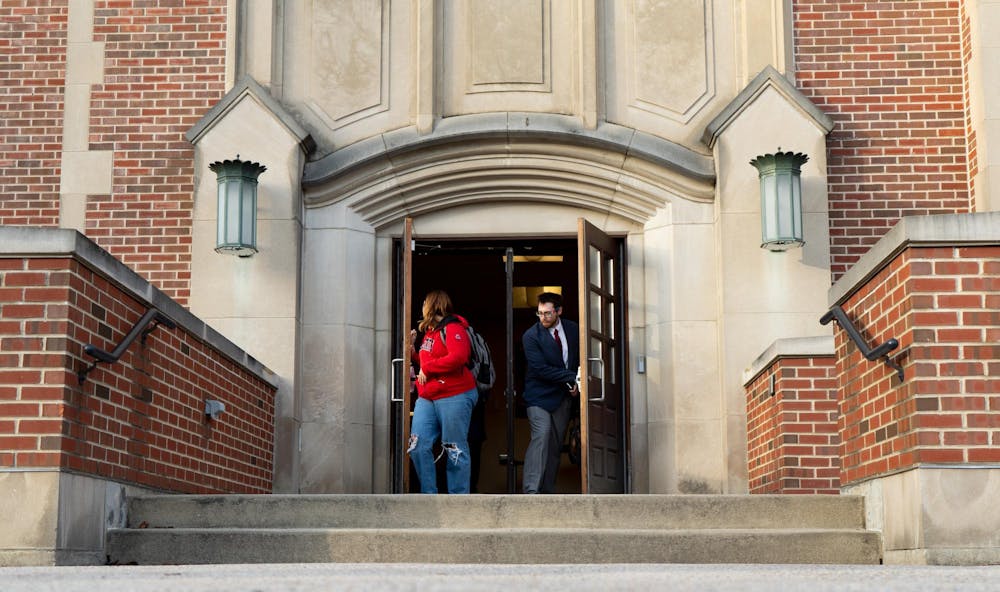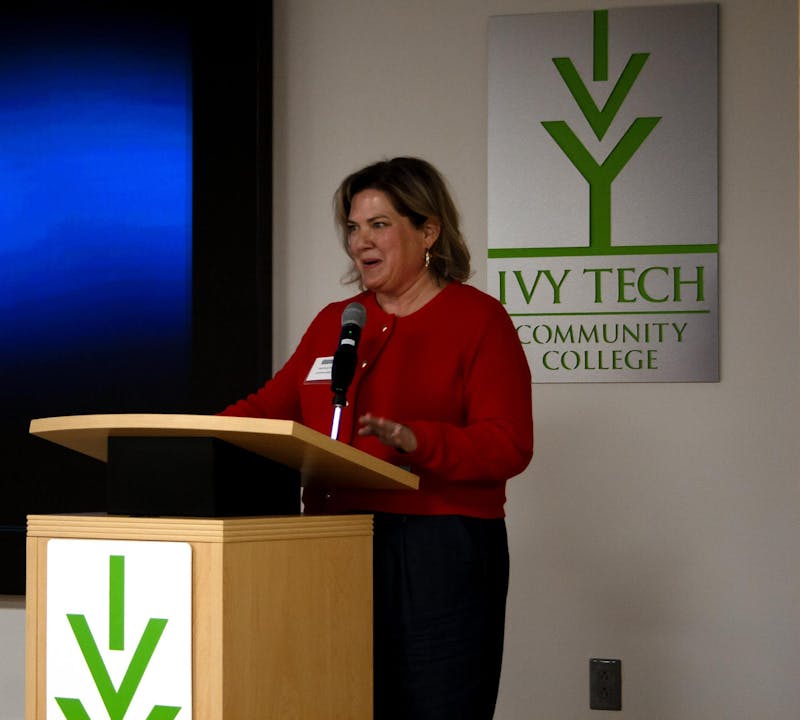Ball State’s College of Sciences and Humanities (CSH) is finding new departmental synergies.
Maureen McCarthy, Dean of the CSH, came before the Ball State Board of Trustees Dec. 13 to reveal a reorganization plan that will impact several departments within the college, including a merger between the Department of Environment, Geology, and Natural Resources and the Geography and Meteorology Department to form the new School of Earth, Atmosphere and Sustainability (SEAS).
Additionally, the Department of Classics and Religious Studies will move away from the Department of Philosophy and be included within the Department of History.
McCarthy said via email the reorganization was influenced by faculty discussions about shared academic interests and exploring more opportunities for collaboration, noting “faculty in the respective departments had synergies they believed would lead to exciting research and curricular commonalities.”
She said reducing the number of departments minimizes the number of service responsibilities for faculty members, giving them more time to focus on increasing opportunities to work together on research projects and develop academic programs.
The reorganization process to achieve this began three years ago, beginning with discussions among department chairs, followed by a task force of faculty members who conducted a root-cause analysis and explored potential mergers that would work among the departments.
As a part of the process, faculty were also invited to participate in planning for the mergers.
“The first step was to engage chairs of all departments in a conversation about possible reconfigurations,” McCarthy said. “The second step was to convene a task force of faculty to engage in discussions.”
Despite these changes, McCarthy clarified students with majors and minors in the transitioning departments will continue to have access to the courses and resources they need, as academic programs are still expected to “thrive.”
“The college continues to achieve the broader vision of educating students to make discoveries and change the world,” McCarthy said. “Students learn in-demand skills that transcend industries and support lifelong success.”
Associate Professor of Religious Studies Matthew Hotham co-authored the proposal to break away from the Department of Philosophy and move into the Department of History. After discussions between faculty members, it became clear the merger could benefit everyone involved.
However, some students in the affected departments have mixed reactions to the change. Elijah Sturges, a third-year Ball State student double majoring in history and religious studies with a minor in classics, expressed concerns about the university’s motives behind the merger.
“Trying to increase collaboration between professors sounds good. Perhaps it’s cynicism talking, but I hesitate to say that’s the real reason for this merger,” he said. “I know Ball State is trying to take a bigger angle on our STEM subjects, and of course, lumping religious studies, classics and history into one department will make it less expensive to fund those subjects.”
Despite this skepticism, Sturges said the change could create more academic opportunities.
“I hope to be a religious historian, and one of the nitpicks I have is I don’t see many religious history classes,” he said. “There’s definitely interplay that can [happen in] three of the departments.”
Sturges added that while this transition could expand course offerings, the merger’s most significant impact would likely be on faculty rather than students.
While Hotham is optimistic about the changes, he acknowledged the challenges ahead, such as transferring offices and departmental documentation from North Quadrangle Building to Burkhardt Building, where the Department of History is housed.

One concern with this is the future of the meditation and reflection room currently located in the North Quadrangle Building in room 232, which students can use for personal prayer if they wish. Hotham said discussions about whether the room will stay in its current location or be relocated to the Burkhardt Building have yet to occur.
While the long-term plans for the space are still unclear, Hotham is committed to ensuring it continues to exist in some capacity as he’s “invested in making sure it has a future somewhere.”
As part of the departmental reorganization, religious studies will also be breaking away from its long-standing alignment with the Department of Philosophy to join the Department of History. While this does present new opportunities for collaboration, it also marks the end of an academic partnership, leaving the Department of Philosophy with fewer faculty members, Hotham said.
When the Department of Religious Studies was asked to consider potential merger partners, Hotham said the decision was not about leaving the Department of Philosophy behind but rather about making sure religious studies was with a department that would offer them more resources and structural support.
He and his colleague, Joseph Marchal, a professor of religious studies, had taken on various service responsibilities within the Department of Philosophy, including leadership roles on committees for the past two years.
Hotham said the imbalance now raises concerns for the long-term stability of philosophy, a department that, like religious studies, has faced declining faculty numbers in recent years.
“There is just a certain minimum amount of work that has to be done to be a department, and the fewer people you have to do it, the more each individual has to do,” he said.
The formation of SEAS brings together the Department of Environment, Geology and Natural Resources and the Department of Geography and Meteorology, creating a unified academic department focused on environmental and atmospheric sciences.
Petra Zimmermann, chair of both transitioning departments, said the merger was logical.
“Reorganizations and mergers are part of the current higher education landscape,” she said via email. “The union between environment, geology, natural resources, geography and meteorology seemed like a natural fit.”
Zimmermann played an active role in the transition, meeting individually with faculty members last fall to present the potential advantages of a merger. She emphasized that faculty were allowed to provide input, and when both departments met to discuss the idea, the majority voted in favor of the merger.
Despite these structural changes, Zimmermann reassured students their academic experience would remain unchanged but encouraged students to explore more coursework outside their major.
Second-year natural resources and environmental management major Thomas Wallbank views the merger as a positive step.
“I do expect there to be benefits when combining these departments,” he said. “Combined, they take a larger portion of the student population and can get more resources and funding.”
He also believes the interdisciplinary aspect of the merger will provide students with a stronger academic foundation.
“Having a wide understanding of different principles makes you a better candidate for jobs,” he said. “The variety of credits needed in one of these majors is already diverse to showcase that idea, but this will make it stronger with fewer restrictions.”
One of the key benefits of SEAS is the potential for increased collaboration among faculty and students. Zimmermann said faculty from both departments have already worked together on research projects and served on graduate student committees, particularly within the Environmental Science PhD program.
“Collaboration and so-called water cooler talk — which can generate ideas — happens best when faculty are proximate to one another,” she said. “They will also be able to exchange thoughts and inspirations in the same faculty meeting.”
While no immediate plans exist to recruit additional faculty or restructure workloads, discussions about new courses and research initiatives are underway.
She is optimistic about the future of SEAS within the CSH and believes the school’s new interdisciplinary aspect will strengthen research, education and experiences for students.
As part of the CSH reorganization, the Department of Anthropology and the Department of Sociology are merging to form a single department. While this is a structural change, faculty members emphasized the academic programs within each department will remain individualized.
Chair of the Department of Anthropology, Robert Phillips, described the merger as an ongoing process, with many details still being finalized.
“Over time, we may develop shared goals. Both departments are open to interdisciplinary collaboration, and we all look forward to exploring the ways that we can support each other’s programs in and out of the classroom,” he said.
Chair of the Department of Sociology, Chadwick Menning, shared the sentiment.
“We expect sociology will remain a distinct program in a combined department, and the requirements for that program will remain the same for now,” he said, acknowledging that the merger could eventually lead to new interdisciplinary opportunities.
Both Phillips and Menning see the merger as a chance to create additional student offerings.
“This includes potentially developing new course offerings, internship opportunities and innovative community engagement initiatives,” Phillips said.
Looking forward, Hotham said further changes could be on the horizon, across all departments.
For now, faculty and students are focused on adjusting to the new departmental structures and exploring the possibility of more interdisciplinary opportunities.
Contact Meghan Braddy via email at meghan.braddy@bsu.edu or on X @meghan_braddy.





The Daily News welcomes thoughtful discussion on all of our stories, but please keep comments civil and on-topic. Read our full guidelines here.